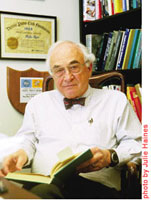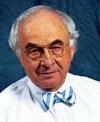| Home | Blog | Ask This | Showcase | Commentary | Comments | About Us | Contributors | Contact Us |

Phil Meyer, raising the ante againSHOWCASE | March 88, 2008Following is the text of Meyer’s talk on the occasion of a two-day symposium celebrating his retirement as holder of the Knight chair at the University of North Carolina's School of Journalism and Mass Communications. By Philip Meyer Perhaps the most quoted line in Precision Journalism, is this: “They are raising the ante on what it takes to become a journalist.” I used it to open the third edition, published in 1991. And now I have a confession to make. At the time I wrote it, I could not be certain that it was true. It was time to raise the ante, sure enough. But the mainstream media were being painfully slow to keep up with the need for better and more skillful journalism. I guess I thought that if I announced that standards were rising, perhaps that might nudge the process along a bit. An “ante,” of course is what you pay to buy into each hand of a poker game. It ensures that you have a stake, some commitment, before you see your cards. Putting time and money on the table for journalism education is the way that most people in newspapers and broadcasting make their commitment. And now, 17 years after I made that rash claim, the ante really is being raised. This time, I am certain. And technology is the cause. While we were worrying about other things, learning to do journalism got harder. And it’s going to get harder still. The hunter-gatherer model of journalism is no longer sufficient. Citizens can do their own hunting and gathering on the Internet. What they need is somebody to add value to that information by processing it – digesting it, organizing it, making it usable. This is why we still need newspapers – or something like them. Ronald Coase, the British economist, once asked why we need business firms. Why can’t all their activities be coordinated by individuals contracting with one another instead of working in a bureaucratic, command-and-control environment? The answer, he said, is transaction costs. If a manager had to negotiate with a free-lancer for every task, the cost in time would be unbearably high. Searching for information on the Internet involves something like transaction costs because we have so many varied sources to evaluate. We need somebody we trust to organize them for us. That can be the task of the new journalism. So far, it seems from my old-guy perspective, new technology has been employed mainly to give us clever new ways to do the hunting, gathering and delivery of information. And I worry that journalism education will spend so much time on the new tools that we’ll short-change our students – and, by extension, society – in the value-added part. Piling up facts and putting them in clever packages isn’t enough. We need to supply the interpretive framework, too. Traditional journalism goes after events. But behind every event there is a pattern. And behind the pattern there is structure. (This concept is from Peter Senge in his management book, The Fifth Dimension: the Art and Practice of the Learning Organization.) Citizens, to be enlightened need to know more about public affairs than just the events. They must understand at those higher conceptual levels, the patterns and the structures. Event-centered coverage of public meetings and press conferences won’t do that. The current Columbia Journalism Review has a good example. Dean Starkman writes that business reporters were so preoccupied with financial performance, strategies, and profiling corporate leaders that they missed, for the most part, the big story of the credit squeeze on the middle class. They saw the events but not the pattern. In academe, we have a parallel concern. Patterns and structures are what lead us to theory. The social sciences have been chronically short on theory. When I was a first-semester graduate student at this University, I took Alexander Heard’s seminar in the scope and methods of political science. In our conversations, sparked by an amazing list of guest speakers, including Angus Campbell and David Truman, the scarcity of theory was a recurring theme. Without theory, research isn’t cumulative. It just stacks up loosely related facts. That was in 1956, the same year that Robert A. Dahl published his modestly titled A Preface to Democratic Theory. Dahl argued that social checks and balances were far more important for the protection of our liberties than the checks and balances in the Constitution. Society protects the Constitution as much as the Constitution protects society. Dahl’s model makes our role all the more important. There won’t be an enlightened public to keep democratic values alive if we don’t do our job. I began practicing journalism in the waning days of the Industrial Revolution. Mass media were a product of the Industrial Age. Its starting point was 1776, which I am sure you will recognize as the year that James Watt invented the reciprocating steam engine. Industrial power enabled mass production, which yielded standardized products, which needed mass media to sell them. You see the parallel: standardized products, standardized information. Newspapers were the main mass medium for most of the 20th century, and they evolved toward natural monopolies, only in part because of their high capital costs. The other factor was that buyers and sellers in that standardized world needed the efficiency of a single marketplace to minimize their transaction costs. I’ve been reading about a nice example in a new history of the Kansas City Star by Harry Haskell, the grandson of an early Star editor. (Boss-Busters and Sin Hounds: Kansas City and Its Star) William Rockhill Nelson started the paper with a hand-fed flatbed press in 1880, a time when Kansas City already had four English-language newspapers. Nelson gained dominance in that market by becoming an influential voice in the development of the young city, helping to plan its wide boulevards and green parks. Advertisers want influence, and they find it easier to get if they can piggyback on a medium with influence of its own. When journalism schools arrived, their mission was a simple one: provide cheap labor for the newspaper industry. That emphasis left us a little bit short on the other functions of a university, research and service – present company excepted, of course. And that might be why so many of the main theories in mass communication evolved elsewhere. Paul Lazarsfeld got his two-step flow through sociology. He had chosen political communication to study because its output, voting behavior, was easy to quantify. Gate-keeping theory originated in social psychology. And a promising recent development, the idea of the public’s attention as a scarce economic good, came from a political scientist, Herbert Simon. Journalism schools were closely tied to an industry that was so successful that it didn’t see any need for theory. The owners of the dominant newspapers could make money whether their products were good or bad. And so the research they wanted looked for trivial, low-risk ways of optimizing content and minimizing cost. We now live in a different world. After World War II, specialized media began prospering at the expense of more general media. As Alvin Toffler put it well before the Internet, instead of a few messages going to many people, we began having a system that generates many messages, each going to relatively few people. Newspapers used to bring us together. The media that are replacing them may drive us apart. How can this system yield enlightened understanding by the public? What happens if we all gravitate to narrowly-directed messages from senders who would rather reinforce our prejudices? They are motivated to do it, of course, because that’s an easier way to get our attention. The other way to get attention is to provide entertainment, and that takes more of the scarce supply away from public issues. Remember Neal Postman. In Amusing Ourselves to Death he recalled the two dystopian novels that I read in college, George Orwell’s 1984 and Aldous Huxley’s Brave New World. Orwell saw totalitarian government arising through perpetual war and high-tech surveillance of the citizens. Huxley envisioned government control exercised with voluntarily ingested drugs and rigid social stratification. Postman claimed that Huxley had it right except that our drug is entertainment. This was 1985! Just look around, and you can see how the ways of being entertained have multiplied since then. When I see students who know everything about popular culture and next to nothing about public affairs, I tend to agree with Postman. On the other hand, the events of the past five years have lent some support to the Orwellian model as well. The world is changing very fast, and we need to understand what is happening and its implications for democracy. As faculty, we have the responsibility to discover, as well as impart, the truth. And we have the privilege of investigating whatever interests us. There is plenty to choose from. But without theory, our efforts cannot be cumulative. Ronald Coase, the economist who figured out the importance of transaction costs, noticed this problem in business schools. For years, he said, they concentrated all their research efforts on institutional studies. “Without a theory,” he said, “they had nothing to pass on except a mass of descriptive material waiting for a theory or a fire.” What makes this meeting important is that we are looking for ways to pass on the work that we do. Last week, a newspaper reporter asked me why, at the age of 77, I care so much about the future of journalism. “I have grandchildren,” I explained. But there is more to it than that. I want the work of journalism and journalism education to advance, to be cumulative. I want the conversation to continue. Two decades ago, when the late James A. Carey and I were the guests of Ev Dennis at the Media Studies Center, Jim guided me to the work of Kenneth Burke (The Philosophy of Literary Form) who suggested that life is a conversation. When we enter the room, we find this conversation already under way. It is heated at times. We try to get the drift of it, and then maybe add a few ideas of our own. Our little contribution is attacked by some and defended by others. Then the hour grows late, we have to go, and the conversation continues without us. If we are lucky, what we have said might affect that conversation long after we have left the room. We need to turn our conversation toward an economic theory of journalism. We need to apply existing theory to understanding the processes and effects of the new media. We need to learn how to sell enlightened understanding to the public so that it can preserve its democratic values. The synergy of mass media and mass production is gone, probably forever. Something strange – and possibly dangerous -- is taking its place. We need to understand it. The ante has been raised. I hope you’re ready.
|
||||||||||||




